Granth-Prakashan
(Spiritual way to do a Book Release)
In this material world, there are many authors who are desperate to publish and launch their books in the market. Such a launch happens in sophisticated places with lot of public attention. But what about publishing spiritual books? Does publishing these books require so much attention? Indeed not, because the main aim here is not to gain unnecessary attention to the publisher but to draw attention to the content of spiritual books for the benefit of mankind.
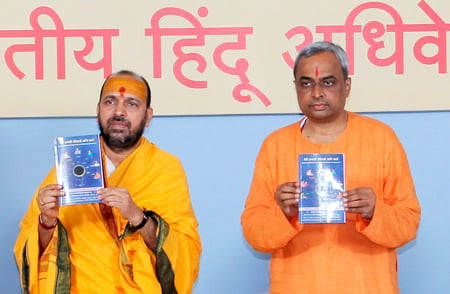
1. Meaning of the word prakashan
The Hindi word ‘prakashan’ means to publish. Spiritually, ‘prakashan’ means providing direction or giving way to the flow of creativity in the respective component with the blessings of a Deity, and thereby activating it for the sake of society.
2. Shlokas to be recited
during the Release function of a Holy text or book
A. At the commencement of the programme
वंदे सरस्वतीं देवीं वीणापुस्तकधारिणीम् ।
पद्मासनां शुभ्रवस्त्रां कलाविद्याप्रदायिनीम् ।।
Meaning: I pay obeisance to Saraswati devi, who is seated on a lotus, draped in white, holding a Holy text and a veena (A stringed musical instrument), and who is the bestower of knowledge.
B. In between the programme
या कुन्देन्दुतुषारहारधवला या शुभ्रवस्त्रावृता
या वीणावरदण्डमण्डितकरा या श्वेतपद्मासना ।
या ब्रह्माच्युतशङ्करप्रभृतिभिर्देवैः सदा वन्दिता
सा मां पातु सरस्वती भगवती निःशेषजाड्यापहा ।।
Meaning : We pray to the one who is fair as the jasmine, as the moonlight and pearl necklaces, one who is draped in white, one whose hand is adorned by the veena and one who is seated on a white lotus. The one who is worshipped by Brahma, Shrivishnu, Deity Shiva amongst many others. O Saraswatidevi, remove the darkness, denseness and dullness in our intellect and protect us.
C. At the conclusion of the programme
गुरुर्ब्रह्मा गुरुर्विष्णुर्गुरुर्देवो महेश्वरः ।
गुरुःसाक्षात् परब्रह्म तस्मै श्रीगुरवे नमः ।।’
– A Scholar (Through the medium of Mrs Anjali Gadgil, 9.12.2006)
3. Steps in the function of the release of a Holy text or book
A. Surrendering first to the Deity of knowledge in the form of Shabda-Brahman (Divine Principle in the form of words) from the text, means surrendering to Shri Mahaganapati, invoking Him and praying to manifest in the form of ripples of light from the words.
B. Perform puja (Ritualistic worship) of the Holy feet of Shri Ganapati existing in the form of the text with gandha (Sandalwood paste), kumkum (Saffron), flowers and akshata (Unbroken rice grains).
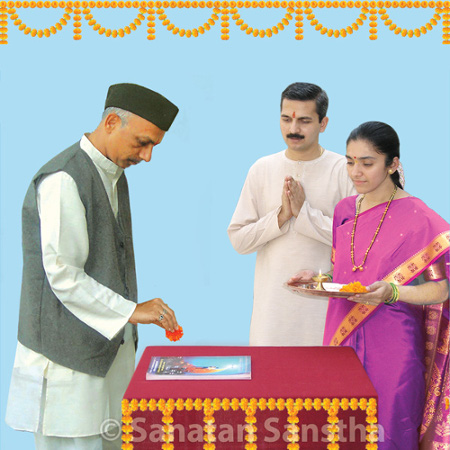
C. Read out a paragraph from the text. (Reading out a paragraph amounts to emitting the Shabda-Brahman of the text into the environment, and through the Sankalp-shakti [Energy of resolve] in the words of Shri Ganesh generated from it, creating a sanskar [Subconscious impression] on samashti [Society].)
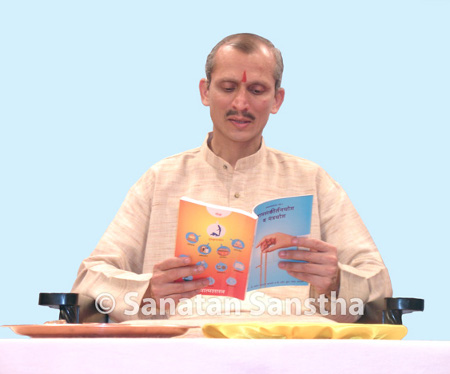
4. Why should we not release a book
by first tying it with a ribbon and then untying it?

The sanskar generated by a ribbon is one that ties the words in bondage, and hence it is an insult to Shabda-Brahman. For this reason, it is incorrect to do Granth-prakashan by first tying a ribbon to the book and then untying it. – A Scholar (Through the medium of Mrs Anjali Gadgil, 5.5.2005)
5. Analysis, based on subtle-knowledge, of release function of Holy text ‘Spiritual Practice’ published by Sanatan Sanstha
On 6.10.2006, in Sanatan’s Ashram at Ramnathi, Goa, H.H. Vijay Vishveshvaram Bhaskarswami (H.H. Kaka Maharaj), disciple of Gurudev Dr Kateswamiji, released Sanatan’s Holy text ‘Spiritual Practice’. Following is the analysis based on subtle-knowledge done by Mrs Anjali Gadgil.
A. Initially, instead of the Holy text ‘Spiritual Practice’, I perceived a void.
B. I felt that, from that void each one gets the Principle of the Deity, which is necessary for him/her.
C. I perceived that from the void, blue colour of Shrikrushna is advancing towards me, and I experienced Anand (Bliss).
D. When H.H. Kaka Maharaj showed the Holy text to the audience, I saw that the front cover of the book was also blue !
E. When I performed circumambulation of the Holy text in the subtle, my mind became thoughtless.
F. First the awareness of going from advait (Non-duality) to dvait (Duality), followed by experiencing Anand of going from dvait to advait : While looking at the book with open eyes, I felt as though I was being pushed back. When I closed my eyes with my gaze fixed on the text, I realized that I was being pulled towards it.
Due to extroversion, while looking at the book with open eyes, body-consciousness was created in the mind. Due to Chaitanya (Divine consciousness) emanating from the book, I had the feeling as though I was being pushed back. When I closed my eyes I experienced Anand, since my mind was attracted to the Chaitanya emanating from it. I felt that the first process was awareness of going from advait to dvait, and the subsequent process was an experience of the Anand of going from dvait to advait.
G. Holding the Holy text in the hand and eyes closed, when I imagined that I am inhaling from bottom to the top of the text on its left side, I experienced heaviness, whereas while inhaling from the right side of the text, I experienced lightness. During the entire experiment, my mind continued to be in a state of Anand. In reality too, the front cover of the Holy text had the face of a dejected individual on the left and the face of a happy individual on the right. Since this text was meant for individual spiritual progress, it was enriched with Chaitanya and was the cause for my constant Anand.

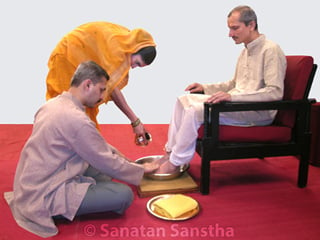 Do you know the correct way of doing Felicitation ?
Do you know the correct way of doing Felicitation ?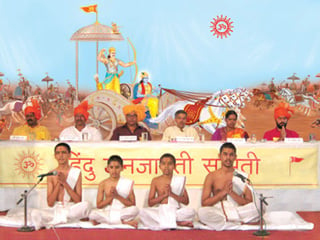 Why are Sanskrit Shlokas recited at functions?
Why are Sanskrit Shlokas recited at functions? Importance of lighting the lamp in functions
Importance of lighting the lamp in functions Presenting a gift
Presenting a gift